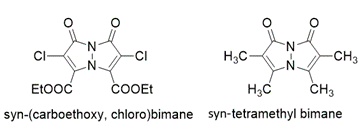Paper Authors and Title
Metodej Dvoracek (Technological University Dublin), Mikhail Filatov, “Synthesis of a Functionalised Bimane Dye”
Abstract
Bimanes or 5-diazabicyclo[3.3.0]octadienediones are a class of chemicals discovered by E.M. Kosower. They exist in two isomers with different optical properties. The syn-isomer of bimanes displays a strong fluorescence, while the anti-isomer is weakly fluorescent but often strongly phosphorescent. Their low molecular mass and simple structure makes them excellent building blocks for functionalised dyes. The work in this thesis focused on the synthesis of syn-(carboethoxy, chloro)bimane and the investigation of its quantum yield, using the simpler syn-(methyl, methyl)bimane as a reference.
Figure 1. Structures of syn-(carboethoxy, chloro)bimane and syn-(methyl, methyl)bimane
Since bimanes are synthesised from a halopyrazolinone, two methods were tested, one using trichloroisocyanuric acid as the chlorinating agent and the other using chlorine gas. The trichloroisocyanuric acid formed two products upon reaction with the pyrazolinone and bimane synthesis failed using this mixture however the reaction can most likely be optimised. The chlorination using Cl2 was successful and using this, syn-(carboethoxy, chloro)bimane and was synthesized in 38% yield. The quantum yield of syn-(carboethoxy, chloro)bimane was found to be strongly dependent on the solvent, with a quantum yield of 0.23 in acetonitrile and 0.44 in dichloromethane. The quantum yield of syn-(methyl, methyl)bimane was found to be 0.71 in acetonitrile and 0.72 in dichloromethane displaying no solvent dependence. Although the quantum yields of syn-(carboethoxy, chloro)bimane are lower, their absorption maxima are about 30 nm higher, pushing it into the visible region, showing that functionalised bimanes are more suitable as dyes.

